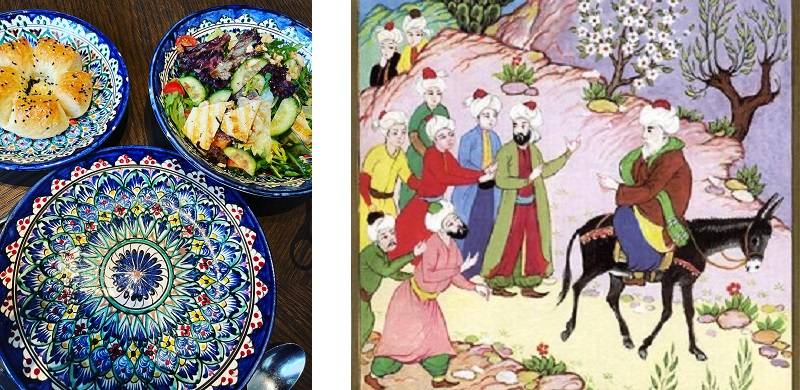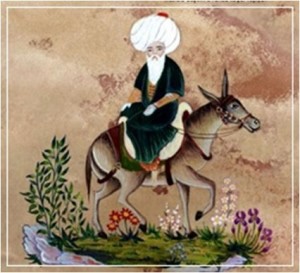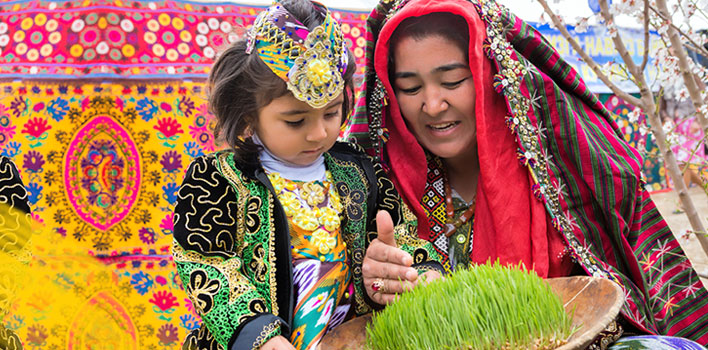
Spring in every culture is a time of rebirth, renewal. In Washington D.C., it is when the tulips and daffodils unfold and warmer days partnering cooling nights. We emerge from our hibernation and prepare ourselves to shed the old and welcome the new. Recently, I found myself in snowy Tashkent during the week of Nowroze. Our family celebrated Nowroze following a Iranian inheritance. I discovered that it is celebrated in many Central Asian cultures outside Iran.
Uzbekistan, having opened to the world recently, is still a land of mystery. It is a landlocked country, and is one of the few which are double landlocked. It is surrounded by five other ‘stans’, and like them, its historical and spiritual traditions are an amalgam of breathtaking Islamic architecture with vestiges of Russian influence. It is often described as the cultural crossroads of Central Asia, particularly as it formed an important part of the Silk route.
The President’s policies are to reform and modernise all aspects of his country’s development, for which he hopes to attract foreign investment. I participated in one such forum recently which bravely hosted over 1000 foreign investors and in some ways marked the end of COVID protocol in the country. It was both interesting and surprisingly educational.
I found myself in Tashkent feeling oddly at home. Like Pakistan, it is overwhelmingly Muslim (95%), has a youth bulge, and everyone postpones difficult discussions with ‘InshaAllah.’ Its past has been shaped largely by the USSR but also culturally by religion. Its The people were good-looking with features that one sees in old miniature paintings. Their cuisine is linked to the several ethnic groups who have left their mark on over the centuries whether perfumed rice dishes prepared using raisins and pomegranates or mantu – meat dumplings found on the Muslim food street in Xian, China. Rather like us, the Uzbeks are fond of dried fruit and nuts, and relish vast amounts of meat pullao (pilov) though theirs is decorated with braised horse meat. This they wash down with copious draughts of green tea from Samarkand. It has almost a flowerlike fragrance to it.
 Culturally, Uzbekistan shares many similarities with countries linked by the ancient Silk Route – Tajikistan, Kazakhstan, Afghanistan and Pakistan. The height of its glory occurred in the 12th century when many of the enlightened philosophers included Ibn Sina and even the legendary comic genius Mullah Nasruddin.
Culturally, Uzbekistan shares many similarities with countries linked by the ancient Silk Route – Tajikistan, Kazakhstan, Afghanistan and Pakistan. The height of its glory occurred in the 12th century when many of the enlightened philosophers included Ibn Sina and even the legendary comic genius Mullah Nasruddin.
A moment of cultural affinity came home to me clearly during an otherwise formal meeting, the Minister in charge started to narrate the anecdote of Mullah Nasruddin. These have been popular in the subcontinent and the region for many centuries and are particularly popular with young children. Most of the stories are narrated as jokes or humorous anecdotes. They were told and retold endlessly in teahouses and caravanserais of Asia. Even today, one can hear them read in homes and on the radio.
Mullah Nasruddin, the wise fool as he is known in many Eastern cultures, was supposed to have been born in Turkey or Bokhara. Nasruddin is known to us under different names in the world. Turks call him “Nasreddin Hoca,” for Kazakhs he is “Koja Nasreddin,” whilst Azerbaijanis, Afghans and Iranians refer to him as “Molla or Mulla Nasrudin.” His universality was even recognised by UNESCO which designated the year 1996 as “Nasreddin Hoca Year.”
It is inherent in a Nasreddin story that it carries meaning at many levels. There is an anecdote, leading to a moral aphorism. They are the Muslim equivalent of Aesop’s fables – designed to convey moral messages through satire. Idreis Shah, the famous Sufi scholar, even dedicated three books to his exploits and its importance to the Sufi mystical tradition. Masters such as Shah used these as ways to increase pupils’ training in wisdom ad even the Nobel Laureate Doris Lessing referred to his antics as parallel to the mind’s workings and referred to their use at a science conference to illustrate physics problems that are difficult to describe.
In gatherings, family meetings, and parties, stories called "latifa" of "effendi" are told about him. There are at least two collections of Uzbek stories alone though my favourite are the shorter anecdotes which are ridiculous and whimsical. Take for example the story in which the Khodja throws yeast into the salt-lake near Aksehir. He knows perfectly well that just a little bit of yeast cannot ferment the great lake into yoghurt. Or the one about the Donkey which is also shown in this beautiful miniature painting. One day Khodja and his students were on the way to their lesson. Khodja was sitting backwards on his donkey. “Khodja'', they asked him, “Why on earth do you sit that way? Isn’t it uncomfortable?” He answered: “If I sit the other way, you would all be behind me and we wouldn’t be face-to-face. Riding this way is better.”Over centuries, new stories have been added and Nasruddin’s repertoire has expanded in number and across regions. The themes in the tales have become part of the folklore of a number of nations and express the national imaginations of a variety of cultures. Although most of them depict Nasruddin in an early small-village setting, the tales deal with concepts that have a certain timelessness. I read them as a child and read them to my own children in turn. They have also inspired beautiful miniature paintings and art in folklore.
And so, my week in Tashkent was transformed into a magical story-telling experience as meetings were full of anecdotes of wisdom, humour and cultural affinity. And wouldn’t it be wonderful if all business could be conducted in this uniquely enjoyable way?
Uzbekistan, having opened to the world recently, is still a land of mystery. It is a landlocked country, and is one of the few which are double landlocked. It is surrounded by five other ‘stans’, and like them, its historical and spiritual traditions are an amalgam of breathtaking Islamic architecture with vestiges of Russian influence. It is often described as the cultural crossroads of Central Asia, particularly as it formed an important part of the Silk route.
The President’s policies are to reform and modernise all aspects of his country’s development, for which he hopes to attract foreign investment. I participated in one such forum recently which bravely hosted over 1000 foreign investors and in some ways marked the end of COVID protocol in the country. It was both interesting and surprisingly educational.
I found myself in Tashkent feeling oddly at home. Like Pakistan, it is overwhelmingly Muslim (95%), has a youth bulge, and everyone postpones difficult discussions with ‘InshaAllah.’ Its past has been shaped largely by the USSR but also culturally by religion. Its The people were good-looking with features that one sees in old miniature paintings. Their cuisine is linked to the several ethnic groups who have left their mark on over the centuries whether perfumed rice dishes prepared using raisins and pomegranates or mantu – meat dumplings found on the Muslim food street in Xian, China. Rather like us, the Uzbeks are fond of dried fruit and nuts, and relish vast amounts of meat pullao (pilov) though theirs is decorated with braised horse meat. This they wash down with copious draughts of green tea from Samarkand. It has almost a flowerlike fragrance to it.
 Culturally, Uzbekistan shares many similarities with countries linked by the ancient Silk Route – Tajikistan, Kazakhstan, Afghanistan and Pakistan. The height of its glory occurred in the 12th century when many of the enlightened philosophers included Ibn Sina and even the legendary comic genius Mullah Nasruddin.
Culturally, Uzbekistan shares many similarities with countries linked by the ancient Silk Route – Tajikistan, Kazakhstan, Afghanistan and Pakistan. The height of its glory occurred in the 12th century when many of the enlightened philosophers included Ibn Sina and even the legendary comic genius Mullah Nasruddin.A moment of cultural affinity came home to me clearly during an otherwise formal meeting, the Minister in charge started to narrate the anecdote of Mullah Nasruddin. These have been popular in the subcontinent and the region for many centuries and are particularly popular with young children. Most of the stories are narrated as jokes or humorous anecdotes. They were told and retold endlessly in teahouses and caravanserais of Asia. Even today, one can hear them read in homes and on the radio.
Mullah Nasruddin, the wise fool as he is known in many Eastern cultures, was supposed to have been born in Turkey or Bokhara. Nasruddin is known to us under different names in the world. Turks call him “Nasreddin Hoca,” for Kazakhs he is “Koja Nasreddin,” whilst Azerbaijanis, Afghans and Iranians refer to him as “Molla or Mulla Nasrudin.” His universality was even recognised by UNESCO which designated the year 1996 as “Nasreddin Hoca Year.”
It is inherent in a Nasreddin story that it carries meaning at many levels. There is an anecdote, leading to a moral aphorism. They are the Muslim equivalent of Aesop’s fables – designed to convey moral messages through satire. Idreis Shah, the famous Sufi scholar, even dedicated three books to his exploits and its importance to the Sufi mystical tradition. Masters such as Shah used these as ways to increase pupils’ training in wisdom ad even the Nobel Laureate Doris Lessing referred to his antics as parallel to the mind’s workings and referred to their use at a science conference to illustrate physics problems that are difficult to describe.

In gatherings, family meetings, and parties, stories called "latifa" of "effendi" are told about him. There are at least two collections of Uzbek stories alone though my favourite are the shorter anecdotes which are ridiculous and whimsical. Take for example the story in which the Khodja throws yeast into the salt-lake near Aksehir. He knows perfectly well that just a little bit of yeast cannot ferment the great lake into yoghurt. Or the one about the Donkey which is also shown in this beautiful miniature painting. One day Khodja and his students were on the way to their lesson. Khodja was sitting backwards on his donkey. “Khodja'', they asked him, “Why on earth do you sit that way? Isn’t it uncomfortable?” He answered: “If I sit the other way, you would all be behind me and we wouldn’t be face-to-face. Riding this way is better.”Over centuries, new stories have been added and Nasruddin’s repertoire has expanded in number and across regions. The themes in the tales have become part of the folklore of a number of nations and express the national imaginations of a variety of cultures. Although most of them depict Nasruddin in an early small-village setting, the tales deal with concepts that have a certain timelessness. I read them as a child and read them to my own children in turn. They have also inspired beautiful miniature paintings and art in folklore.
And so, my week in Tashkent was transformed into a magical story-telling experience as meetings were full of anecdotes of wisdom, humour and cultural affinity. And wouldn’t it be wonderful if all business could be conducted in this uniquely enjoyable way?

